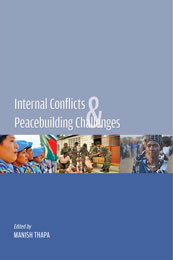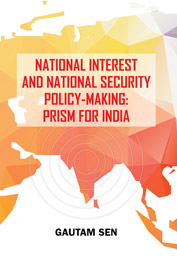Subjects
Recent View(s)
2014: Nationalism And National Security In India
G D Bakshi
Book
2014 was a critical year that saw the revival of Nationalism in India. This book examines Indian Nationalism and takes a close look at India’s National Security. It revisits the somber truth about our freedom struggle. This book uses the technique of Pattern Modelling to study India’s recent history and make forecasts about its collective future. Patterns tend to persist and repeat themselves cyclically. Hence, they become the basis for Heuristic forecasts about the future. This book, therefore, is in two parts. Part one takes an analytical look at our last 70-80 years to identify the patterns. Book two then uses this pattern analysis to make forecasts about our near term future in terms of a Net Assessment that uses the tools of Trends, Drivers and Discontinuities to create a set of Alternative Futures.
Patterns of the Past. The author identifies these patterns of the past as follows:
• India is the oldest civilisation on this earth that has continued unbroken to the present due to its unique assimilative abilities. Political unity however has been very rare phenomenon. It is confined to three episodes of empires that lasted some two centuries each. These were the Mauryan, the Mughal and the British empires. The present Republic is the successor entity of the British empire.
• The British used the concept of imperial justice as equity to thoroughly divide and rule the Indian people. India was such a chaos of warring segments, they said, that only an external power could provide equity and justice.
• They used caste-based censuses and religion-based electorates to divide and rule. Post-independence, the Nehru-Gandhi dynasty replaced the British Imperial monarch as an extrinsic, anglo-phile element which alone could ensure justice between warring religions and caste faultlines.
• Nehru created a false narrative of state that insisted that India was a unique State based on soft power of Ahimsa and Non violence. That it was not based on hard power and felt little need to use the instruments of violence.
• This was patently untrue because historically, it was the INA of Subhash Bose and subsequent mutinies that it inspired in the Royal Indian Navy and Army that had forced the British to leave.
• This distorted national narrative, led the Nehruvian state to lay undue emphasis on pacifism as state policy and marginalise and weaken the Indian Armed forces. This led to the humiliating defeat of 1962 at the hands of the Chinese.
• These distortions were corrected in 1965 and by 1971 India emerged as a strong regional power. However, with the UPA, the Nehruvian Pacifist mindset had returned and India has once more neglected her military for close to two decades. This has emboldened Pakistan to mount an unchecked asymmetric assault
• The Achilliies heel of the Indian political economy has been its pathetic reliance on imported oil. Whenever there was an oil crisis – the Indian political economy collapsed. This happened in 1973-75 (the first oil shock that led to the emergency). It happened in 1990 (when the Indian economy virtually collapsed) and once again in 2013-14 (when the price of oil escalated to $ 140 a barrel and derailed the Indian economy). 2014 was a watershed year.
• Oil shocks derailed the political economy and this in turn, delegitimised the ruling classes. These crises were invariably followed by Gandhian style mass movements to change the ruling elite in India(JPs and Anna Hazare’s movements as also the BJP/RSS mobilisation for 2014 elections).
The Future. Based upon this pattern analysis, this book outlines Three Alternative Futures for India. Though a strong leader has emerged with a clear majority, much hinges upon his ability to turn the economy around, correct our energy dependency on the volatile Middle Eastern market and above all generate some 200 million new jobs by 2020 to meet the challenge of a demographic youth bulge in India’s population. India has to convert economic power into usable hard power to deal with the daunting China- Pakistan combine. It will have to craft a new Asian balance of power by aligning with Japan, Vietnam and South Korea.
Author
Maj Gen (Dr.) G D Bakshi SM,VSM (retd) is a very well-known TV Commentator and India’s leading Military Analyst. He is a prolific writer on matters military with over 30 books to his name.
Contents
Acknowledgements
Prologue
Part I: Narratives of the Past
1 Entropy: The Legacy of Large States
2 The Nation State and Nationalism in India
3 Demographics of Destiny
4 False National Narratives: Rewriting The History of Indian Independence
5 The Perils of Pacifism
6 The Rise of Realism: India’s Iron Lady
7 Non-Alignment 2.0: An Analysis of a Proposed National Security Strategy
8 Energy, Water, and Food Security Architecture in India
9 Year 2014: South Asia’s Year of Destiny?
Part Ii: A Net Assessment of the Future
10 A Net Assessment of Future Security Environments: 2020
11 Environmental Scan: International Security Scenario 2020
12 Regional Security Scenario 2020
13 Internal Security Scenario 2020
14 Alternative Futures: India
15 The Way Ahead: Recommendations for the Future
16 A National Security Agenda for the new Dispensation
Bibliography


 Political Science
Political Science



